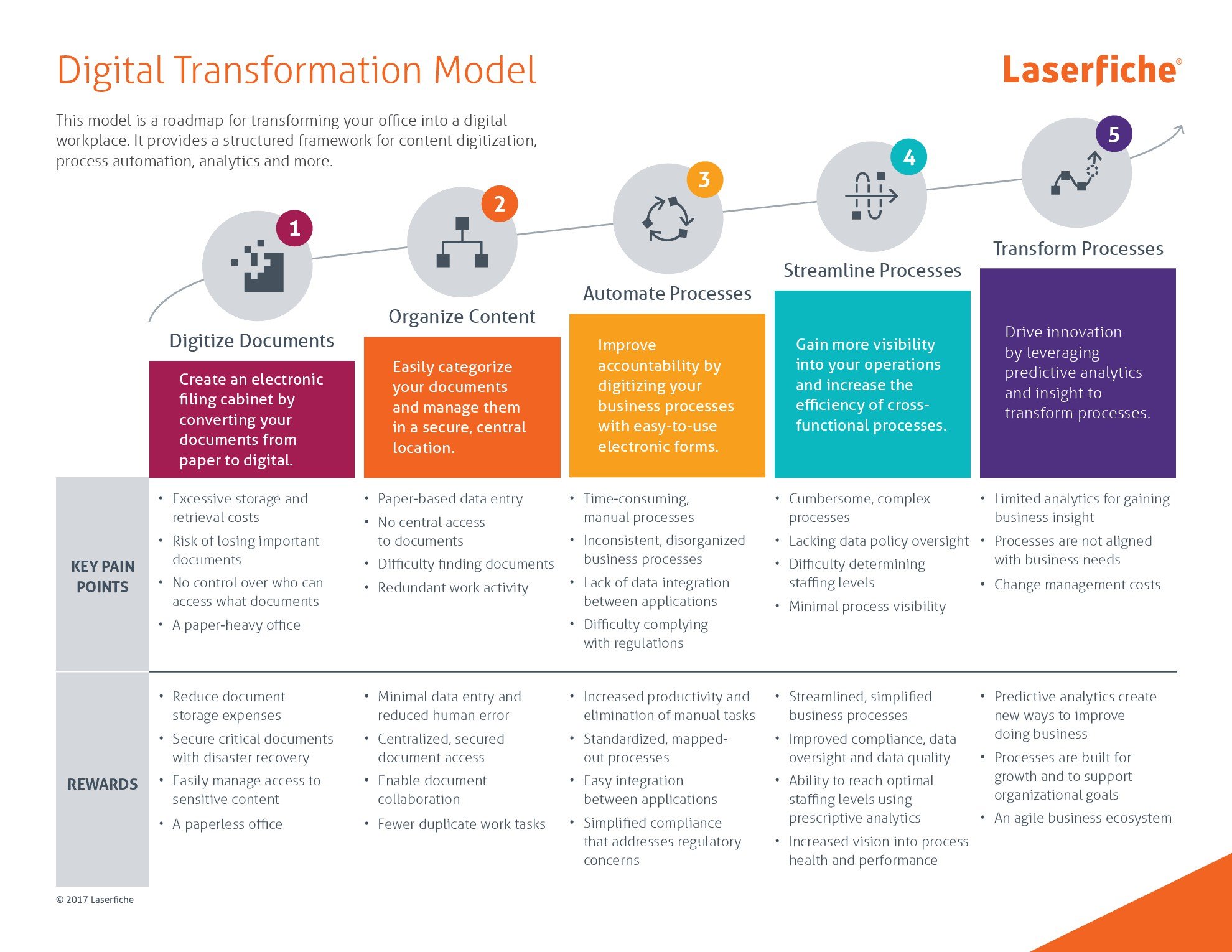Building a successful digital transformation roadmap step by step
December 14, 2021 / 5 min read

Today, every single company has to go through digital transformation. It’s simply a necessity, as everything we do business-wise is online, including sales and client communications.
The bigger your company, the more complex it can be to cope with digital transformation. There are many elements you have to be aware of and keep in mind. And for sure it's not going to happen overnight. You need a roadmap and a well-thought-out strategy that will help you get exactly where you want to be. In this article, we will show you how to build a digital transformation roadmap template and show you an example of a digital roadmap.
First things first: Suppose you haven’t started your digital transformation yet. Why would you be interested in such a time-consuming endeavour? And why do you need a digital transformation roadmap? Once we clarify these questions, it will be easier to show you the full value of a digital roadmap and how to create one.
A roadmap for digital transformation
Shortly put, the main goal of a roadmap is to illustrate how to get to the place you want your company to be in the near future. A digital transformation might be the most challenging project for your company so far. It's good to be aware that it involves some significant changes on three main levels:
- People (here, we talk primarily about your company culture, structure and capacity, as well as your employees’ skills)
- Processes (most likely, you will have to change or at least adjust the procedures and methods you use in your everyday work)
- Physical elements (office, production plants, machines, devices)
Generally speaking, the main idea behind digital transformation is to digitise your company, to make everything digitally-enabled – from IT and marketing, through customer service, to manufacturing and HR. You could say that digital transformation is all about the transition from analogue to digital.
You've probably heard all these IT buzzwords: artificial intelligence, machine learning, cloud computing, the internet of things, automation, industry 4.0. etc. They are all based on modern digital solutions that help your company become more effective. But to make the most of them, you need to lay the groundwork first.
The first thing you have to do is to define your digital strategy.
Start with a well-thought-out digital stratgy
Obviously, you don’t need all these modern digital technologies in your company. At least not at once. If you're just beginning your digital transformation journey, start with baby steps. There is no universal recipe or template that you can apply to your company. Each project is unique and should revolve around your company’s and your customers’ real needs.
There is no art for art’s sake here. Everything has to have a clear and measurable purpose. A digital strategy will help you ensure that it has. Here’s what you should do:
- Determine your business model, goals and customer challenges. At this point, it’s vital to conduct meetings and workshops so that you have the full picture of your company’s current situation, especially concerning potential pain points.
- Analyse your current digital solutions. Take a closer look at your current digital activities. What does your company do and how? What do you use digital products for?
- Decide what you want to achieve. You need a broad vision of what you want your company to be. As we told you earlier, each digital strategy is different. It has to suit your company and your goals. Moreover, it should fit in your overall business ecosystem. If you run an accounting company, you don’t have to deliberate over the internet of things or additive manufacturing because these technologies are completely irrelevant in your situation.
In general, digital strategy shouldn’t be separate from the rest of your business strategy. If you have marketing plans, business plans, various types of analysis or KPIs already done, use them to improve your digital strategy.
Once your digital strategy is done, you can start thinking about creating a brand new digital transformation roadmap.
What is a digital roadmap?
If we had to coin one universal roadmap definition, we’d say it’s a blueprint of how your digital strategy should be implemented. The digital roadmap is all about identifying the stages of the process and the end result you expect to see. This process can be challenging; that’s why many companies cooperate with external strategists and digital consulting companies that help them grasp the big picture and make sure everything has its place.
At the beginning of the digital roadmapping process, it’s vital to conduct a comprehensive review of how your digital strategy works with your company’s development plans and customers’ needs. With the help of an experienced consultant, you develop an objective view of your strategy and assess how much it will cost to implement all these changes.
Digital transformation roadmap tepmlate
As we already mentioned, there are no ready-made templates out there. When you’re working on a digital roadmap template, try to find answers to the following questions:
- What do we have to achieve to go through digital transformation successfully?
- Which technologies, solutions, equipment and processes need transformation?
- What changes need to be implemented in specific departments?
- How does it look time and budget-wise?
We want to show you two examples of what a straightforward digital transformation roadmap could look like:
Digital roadmap/digital transformation roadmap examples

The value of a digital roadmap
There are several crucial benefits with a digital transformation roadmap. For starters, it allows you to organise everything from A to Z. With a roadmap, you never have to ask yourself, “where do we go next?". Everything is clearly explained on your blueprint.
Secondly, with a digital roadmap, you can easily assess how many of your goals the company has managed to achieve so far and what's still to be done. This way, you don't get lost in the process or end it prematurely. And lastly, because you have it all written down, every involved party (including your IT team, marketing team and management) has an instant view into your strategy and the roadmap itself, which helps to keep everyone up to speed, without the need to conduct numerous meetings with everyone who's interested in the progress.
How to structure your digital roadmap
When you’re working on your own digital roadmap template, think about dividing each element into two major sections:
- Streams/objectives: What you want to achieve
- Initiatives/projects: How you want to achieve it
To make your digital business roadmap even more legible, it would be extremely helpful to divide it into every department in your company. In many instances, the HR department will have different goals and challenges than your IT department. Let’s use a simple example:
You run a family-owned FMCG company. The time has come to improve your processes and equipment and make it more digital. The IT department will probably want to increase their computing capabilities, for example by investing in a data warehouse or a cloud computing service. The HR department, on the other hand, is looking for a solution for streamlining screening candidates. Most likely, they will be happy to get a smart AI-based tool that facilitates analysing incoming resumes. As you can see, we have one company but two different challenges and two different solutions.
Therefore, your roadmap should comprise the following elements:
- A graphic presentation in the form of an infographic or a flowchart. There are no bad solutions here, as long as you manage to keep everything transparent.
- An overview can be extremely useful. Gather the most important information in one place. What you want to do, how you want to do it and why you want to do it.
- The expected outcome – it was Seneca who said, “If one does not know to which port one is sailing, no wind is favourable.” Always keep your goals and expected results at the forefront.
- A detailed description of each point – you can’t fit everything on one flowchart. Use it to showcase all the milestones along with the crucial information. Keep everything else in separate files that will serve as an attachment to your digital business strategy and digital roadmap.
How we help clients create a digital strategy roadmap
If you've never developed a digital strategy, let alone a digital strategy roadmap, you might see this task as extremely complicated and time-consuming. Thankfully, you are not alone. If you feel like it's above your competencies or you simply don't have enough time, think about outsourcing. In that case, it's important to work with experienced professionals who have done hundreds of digital roadmaps over the years. Professionals like us!
At NoA Ignite, we help our clients grow digitally. We will gladly help you discover your needs and possible options and develop a comprehensive digital strategy along with a roadmap. Once that's done, it's our job to help you implement all the agreed changes and innovations. You don't have to worry; we will guide you through the entire process.
And believe us, when our job is done, your everyday work will be considerably smoother and more efficient, and your customers will get improved customer service tailored to their expectations. Does this sound interesting? If so, go to the contact section and drop us a line!
Author

Greg Kałucki
Chief Commercial Officer
Greg is a Client Director and Advisor with 15+ years experience in digital platforms and services. He has supported variety of mid-large global organisations in business growth through digitalization.
Related articles
![A well-crafted prompt doesn’t just work once. It works across teams, channels, and campaigns. It can be tweaked for new use cases and refined based on what performs best.]()
June 27, 2025 / 4 min read
Prompts are marketing assets: how to reuse, and scale them
Prompts aren’t throwaway lines. They’re repeatable, scalable assets that can streamline your marketing your team’s output. Learn how to build a prompt library that delivers.
![Woman using a wheelchair in the office settings]()
June 17, 2025 / 5 min read
What is accessibility and why it matters?
Accessibility ensures everyone — including those with disabilities or limitations — can read, navigate, and engage with your content equally.


